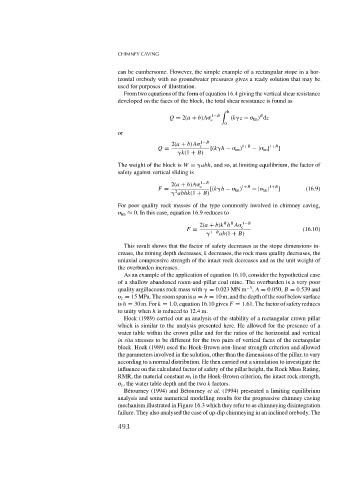Page 511 - Rock Mechanics For Underground Mining
P. 511
CHIMNEY CAVING
can be cumbersome. However, the simple example of a rectangular stope in a hor-
izontal orebody with no groundwater pressures gives a ready solution that may be
used for purposes of illustration.
From two equations of the form of equation 16.4 giving the vertical shear resistance
developed on the faces of the block, the total shear resistance is found as
h
%
B
Q = 2(a + b)A 1−B (k z − tm ) dz
c
0
or
2(a + b)A c 1−B
Q = [(k h − tm ) 1+B −| tm | 1+B ]
k(1 + B)
The weight of the block is W = abh, and so, at limiting equilibrium, the factor of
safety against vertical sliding is
2(a + b)A c 1−B 1+B 1+B
F = [(k h − tm ) −| tm | ] (16.9)
2
abhk(1 + B)
For poor quality rock masses of the type commonly involved in chimney caving,
tm ≈ 0. In this case, equation 16.9 reduces to
B
B
2(a + b)k h A c 1−B
F = (16.10)
1−B ab(1 + B)
This result shows that the factor of safety decreases as the stope dimensions in-
crease, the mining depth decreases, k decreases, the rock mass quality decreases, the
uniaxial compressive strength of the intact rock decreases and as the unit weight of
the overburden increases.
As an example of the application of equation 16.10, consider the hypothetical case
of a shallow abandoned room-and-pillar coal mine. The overburden is a very poor
−3
quality argillaceous rock mass with = 0.023 MN m , A = 0.050, B = 0.539 and
c = 15 MPa. The room span is a = b = 10 m, and the depth of the roof below surface
is h = 30 m. For k = 1.0, equation 16.10 gives F = 1.61. The factor of safety reduces
to unity when h is reduced to 12.4 m.
Hoek (1989) carried out an analysis of the stability of a rectangular crown pillar
which is similar to the analysis presented here. He allowed for the presence of a
water table within the crown pillar and for the ratios of the horizontal and vertical
in situ stresses to be different for the two pairs of vertical faces of the rectangular
block. Hoek (1989) used the Hoek-Brown non-linear strength criterion and allowed
the parameters involved in the solution, other than the dimensions of the pillar, to vary
according to a normal distribution. He then carried out a simulation to investigate the
influence on the calculated factor of safety of the pillar height, the Rock Mass Rating,
RMR, the material constant m i in the Hoek-Brown criterion, the intact rock strength,
c , the water table depth and the two k factors.
B´etourney (1994) and B´etourney et al. (1994) presented a limiting equilibrium
analysis and some numerical modelling results for the progressive chimney caving
mechanism illustrated in Figure 16.3 which they refer to as chimneying disintegration
failure. They also analysed the case of up-dip chimneying in an inclined orebody. The
493

